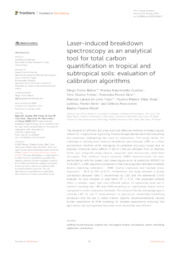Laser-induced breakdown spectroscopy as an analytical tool for total carbon quantification in tropical and subtropical soils: evaluation of calibration algorithms.
Laser-induced breakdown spectroscopy as an analytical tool for total carbon quantification in tropical and subtropical soils: evaluation of calibration algorithms.
Autoria: BABOS, D. V.; GUEDES, W. N.; FREITAS, V. S.; SILVA, F. P.; TOZO, M. L. L.; VILLAS-BOAS, P. R.; MARTIN NETO, L.; MILORI, D. M. B. P.
Resumo: The demand for efficient, accurate, and cost-effective methods of measuring soil carbon (C) in agriculture is growing. Traditional approaches are time consuming and expensive, highlighting the need for alternatives. This study tackles the challenge of utilizing laser-induced breakdown spectroscopy (LIBS) as a more economical method while managing its potential accuracy issues due to physical–chemical matrix effects. A set of 1,019 soil samples from 11 Brazilian farms was analyzed using various univariate and multivariate calibration strategies. The artificial neural network (ANN) demonstrated the best performance with the lowest root mean square error of prediction (RMSEP) of 0.48 wt% C, a 28% reduction compared to the following best calibration method (matrix-matching calibration – MMC inverse regression and multiple linear regression – MLR at 0.67 wt% C). Furthermore, the study revealed a strong correlation between total C determined by LIBS and the elemental CHNS analyzer for soils samples in nine farms (R² ? 0.73). The proposed method offers a reliable, rapid, and cost-efficient means of measuring total soil C content, showing that LIBS and ANN modeling can significantly reduce errors compared to other calibration methods. This research fills the knowledge gap in utilizing LIBS for soil C measurement in agriculture, potentially benefiting producers and the soil C credit market. Specific recommendations include further exploration of ANN modeling for broader applications, ensuring that agricultural soil management becomes more accessible and efficient.
Ano de publicação: 2024
Tipo de publicação: Artigo de periódico
Unidade: Embrapa Instrumentação
Palavras-chave: Artificial neural network, Matrix-matching calibration, Tropical soil
Observações
1 - Por padrão são exibidas publicações dos últimos 20 anos. Para encontrar publicações mais antigas, configure o filtro ano de publicação, colocando o ano a partir do qual você deseja encontrar publicações. O filtro está na coluna da esquerda na busca acima.
2 - Para ler algumas publicações da Embrapa (apenas as que estão em formato ePub), é necessário ter, no celular ou computador, um desses softwares gratuitos. Sistemas Android: Google Play Livros; IOS: iBooks; Windows e Linux: software Calibre.
Acesse outras publicações
Acesse a Base de Dados da Pesquisa Agropecuária (BDPA) para consultar o acervo completo das bibliotecas da Embrapa.

